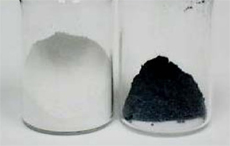博文
黑色的纳米二氧化钛
|||
21 January 2011
Researchers in the US have used hydrogenation to introduce disorder into titanium dioxide nanocrystals, increasing the amount of solar light they absorb. They hope the black TiO2 produced could be used to generate cheap hydrogen fuel.
TiO2 nanocrystals are well-known semiconductors that can catalyse solar powered reactions such as splitting water. However, TiO2 mainly absorbs in the UV part of the spectrum so scientists hope that lowering its band gap - the energy gap between the valance and conduction band - will also enable it to absorb visible and infrared light.
Previously researchers have lowered the band gap by doping TiO2 with metal or non-metal atoms, or by introducing intrinsic defects into TiO2 crystals. But while these methods increase the amount of visible light absorbed by the material - creating 'dirty' brown TiO2 nanoparticles - they still do not absorb in the infrared.

|
Unmodified white and disorder-engineered black TiO2 nanocrystals © Science |
Samuel Mao, Peter Yu and colleagues at the University of California at Berkeley instead used hydrogenation to create a black form TiO2 which absorbs light in the UV, visible and infrared part of the spectrum. They found that the hydrogenation process created disorders in the surface layer of the nanocrystal. Based on their calculations they suggest the hydrogen also 'mops up' broken titanium and oxygen bonds, forming complexes which lower the band gap to the near infrared.
'We have finally succeeded in making a TiO2 which is black in colour,' says Yu. 'Even better, the layer of black TiO2 is on the surface of more-or-less perfect TiO2, so the surface layer will absorb infrared and visible light while the centre of the nanoparticle will still absorb UV light.'
Max Lu , an expert on functional nanomaterials at the University of Queensland, Australia, thinks this is a significant breakthrough in TiO2 photocatalysis. 'The hydrogenation approach is novel and unique among many methods of surface doping or modification of TiO2 to increase photocatalytic activity under visible light irradiation,' he says.
The researchers demonstrated that the black TiO2 was able to catalyse the photo-decomposition of organic molecules much better than normal nanophase TiO2. They also found its ability to catalyse the splitting of water into hydrogen and oxygen under sunlight was greatly improved. 'Compared to conventional TiO2 and other oxide materials it exhibits significantly higher efficiency under the same conditions,' says Mao.
The group hopes that this activity might lead to cheaper ways of generating hydrogen in a clean and efficient way. 'Hydrogen is potentially the cleanest fuel for the future,' says Mao. 'But right now generating hydrogen is relatively expensive. If there is a way to generate hydrogen efficiently and at low cost - if we can just put a special catalyst into water and illuminate it with sunlight - we can imagine this will become one of the least expensive ways to generate clean fuel.'
https://blog.sciencenet.cn/blog-260340-407693.html
上一篇:科学网的墓志铭
下一篇:山东农业大学的花生